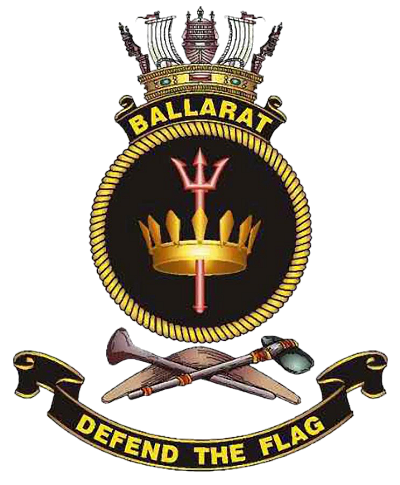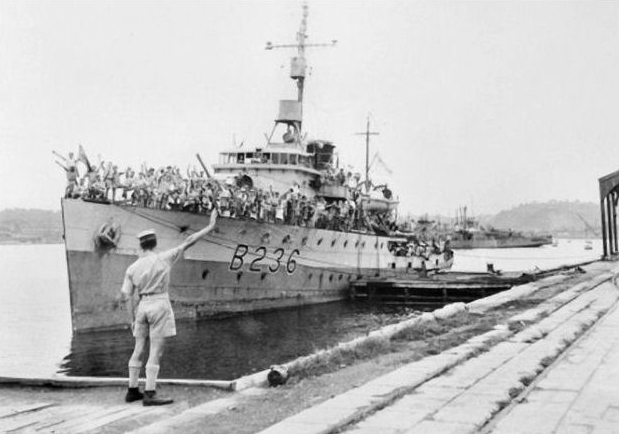Fleet Minesweeper

Battle Honours
New Guinea 1942 - 44
Pacific 1941 - 1945
Okinawa 1945
Specifications
Bathurst-class corvette
Builder: H.M.A. Naval Dockyard in Williamstown, Victoria
Displacement: 650 tons
Length: 180 ft
Beam: 31 ft
Draught: 8 ft 6 in
Propulsion: triple expansion engine, 2 shafts. 2,000 hp Speed: 15 Knots rmament: 1 12 Ponder, later1 × QF 4 inch Mk XIX gun, 3 × Oerlikon 20 mm cannons (later 4), 1 × Bofors 40 mm gun (installed later), 2 x.303 Vickers machine guns, 40 Depth charges (4 throwers and 2 chutes) Crew complement: 85
Commanding Officers
Lt. Alfred Dudley Barling, RANR(S) 20 Apr 1941
Lt. Donald MacLeman, RANR(S) 22 Mar 1943
Lt. Cecil Donald Dykes, RANR(S) 14 Nov 1943
Lt.Cdr. Gordon Alexander Keith, RANR(S) 12 Jun 1944
Cdr. Franklyn Bryce Morris, RAN 1 Dec 1944
Cdr. Neven Robinson Read, RAN 19 Jun 1945 - Nov 1945
Related items
None
Reminiscences
None
Gallery
None
H.M.A.S. BALLARAT

Early history
A Bathurst class Minesweeper ordered from the Williamstown Naval Dockyard, Williamstown, Victoria on December 4th 1939. Her keel was laid down 1April 9th 1940 and she was launched December 10th 1940
HMAS BALLARAT commissioned at Melbourne on August 30th 1941 under the command of Lt. Cdr. Alfred D. Barling RANR(S). After trials in the Melbourne area BALLARAT sailed for Sydney on September 20th 1941. Three days later the ship joined the 20th Minesweeping Flotilla, based in Sydney. On November 1st 1941 BALLARAT sailed for Jervis Bay to give anti-submarine protection to the transport QUEEN MARY. That ship and another giant liner of the Cunard Line, QUEEN ELIZABETH, were to comprise Convoy US.13 to the Middle East, the troops embarked being mainly from the 6th, 7th and 9th Australian Divisions. After embarkation of troops at Sydney the transports proceeded to Jervis Bay, whence they sailed for the Middle East on November 3rd. BALLARAT returned to Sydney the same day.
On November 14th 1941, BALLARAT departed Sydney towing Oil Lighter No 1. The vessels proceeded via Brisbane, Townsville and Thursday Island to Darwin, where they arrived on December 8th. Two days later BALLARAT commenced escort duty between Darwin, Timor and Ambon. She saw action early in her career, arriving at Batavia early in January 1942. She then proceeded to Singapore. After leaving Singapore on February 3rd 1942 she carried out patrols in Banka Strait ('Bomb Alley'), and was also employed in rescuing shipwrecked crews and carrying out demolition work.
BALLARAT carried out one of the largest rescue operations, picking up 215 survivors from the MV DERRYMORE, sixty miles North-West of Batavia on February 14th 1942. The DERRYMORE had been sunk by Japanese submarine in position 5°18' S, 106°20' E. amongst those rescued by BALLARAT was F/L John Gorton RAAF, who was later to become Prime Minister of Australia.
She landed parties at Oosthaven for demolition, which was successfully carried out without loss. With sister ships, BALLARAT took a prominent part in the evacuation of Sumatra, operating from Palembang. She was the last RAN ship to leave, staying behind to sink a small unseaworthy minesweeper. The ship then returned to Australia and was employed on convoy escort work, mainly to New Guinea. In November she and her sister ship HMAS KATOOMBA were heavily attacked by Japanese dive-bombers. In December 1942 BALLARAT and her sister ships HMAS BROOME and HMAS COLAC were detailed to transport Australian troops and land them as far forward as possible in the Buna area. The three vessels reached the landing point at Cape Sudest near Oro Bay without incident, but a few minutes later unidentified aircraft began dropping flares. Because of the threat of attack from enemy aircraft and from enemy warships believed to be in the area it was decided to retire temporarily after only 46 men had disembarked out of a total of 762. Later the same day (December 14th) the operation was successfully completed using a new landing position and under cover of darkness all troops were put safely ashore. During the remainder of the month BALLARAT was involved in troop carrying on three further occasions.
In April 1943 BALLARAT was ordered to operate off the Australian east coast to counter the Japanese submarine menace. Returning north for escort duty to New Guinea in January 1944 BALLARAT was later employed between Thursday Island and Darwin. In August 1944 she ferried troops from Eilanden River (southern Dutch New Guinea) bringing them without loss to Merauke.
Allocated to the British Pacific Fleet
In 1945, she was minesweeping off Sydney prior to the arrival of the British Pacific Fleet, departing for Manus on February 25th and arriving at Leyte Gulf on March 26th. BALLARAT then participated in the operation for the capture of Okinawa (March-May 1945). BALLARAT took part in the surrender ceremony at Tokyo, after which she was engaged in minesweeping in the Hong Kong area with the 20th and 21st Minesweeping Flotillas.
Post War history
HMAS BALLARAT was damaged by a mine at Amoy on November 6th 1945, and returned to Melbourne on December 13th where the ship's company went on long leave. At the conclusion of hostilities BALLARAT had steamed 130,000 miles. The ship paid off into Reserve at Sydney on September 27th 1946 and was sold to a Hong Kong shipping company, China Traders Ltd., on July 10th 1947. However, BALLARAT did not leave Australian waters, and in December 1950 she was resold to the Ta Hing Co. (Hong Kong) Ltd. She was subsequently refitted for the Chinese coastal trade and renamed CARMENCITA. In January 1951, however, the Commonwealth Government issued a Statutory Order banning her from proceeding to Chinese waters. In 1953 she was again sold, on this occasion to John Manners and Co (Aust.) Pty Ltd, Sydney. It has been reported that the ship was broken up in 1953.
Last modified: 23 February 2023
Primary information sources
Additional sources:
Photo & history by John Lyall November 2009
Comments (0)